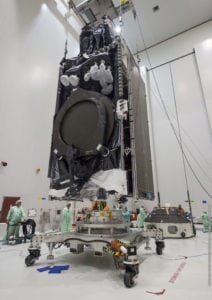Latest News

Intelsat-33e. Photo: Intelsat
Rocket engines made by Aerojet Rocketdyne are now providing in-flight maneuvers for the Intelsat 33e communications satellite, which launched aboard an Arianespace Ariane 5 rocket from Guiana Space Centre in French Guiana on Aug. 24, 2016. Boeing Satellite Systems International, which built the satellite, has announced that the spacecraft is now operational. Intelsat 33e represents the inaugural mission of Aerojet Rocketdyne’s 100-volt fuel-efficient electric propulsion subsystem. This improved fuel efficiency reduces propellant mass by several hundred pounds, helping to enable the high throughput capability of this new Intelsat Epic Next Generation (EpicNG) satellite.
In addition to the electric propulsion subsystem, Aerojet Rocketdyne propulsion on the Intelsat 33e mission includes 16 monopropellant rocket engines: 12 four-Newton MR-111C hydrazine and four 22-Newton MR-106L hydrazine engines, all of which provide attitude control and adjustment, east-west stationkeeping, spin control, decommissioning and settling burns. The MR-111 and MR-106 engines have extensive flight history, each with more than 2,000 flight thrusters delivered with 100 percent mission success.
The electric propulsion subsystem provided by Aerojet Rocketdyne includes a 4.4kW power processing unit, relay box, electrical harnessing and six 2.2kW MR-510 electric arcjet thrusters. Aerojet Rocketdyne has flown more than 170 MR-510 arcjet thrusters with 100 percent mission success, according to the company.
Intelsat 33e is the second of six Intelsat EpicNG satellites being built by Boeing. Intelsat EpicNG is a high performance, next generation satellite platform that delivers global high-throughput capability. Intelsat 33e offers coverage in Europe, Africa, the Middle East and Asia. The remaining three Intelsat EpicNG satellites, also being built by Boeing, will all include the same complement of six Aerojet Rocketdyne electric propulsion thrusters for north-south stationkeeping, and 16 hydrazine rocket engines.
Get the latest Via Satellite news!
Subscribe Now